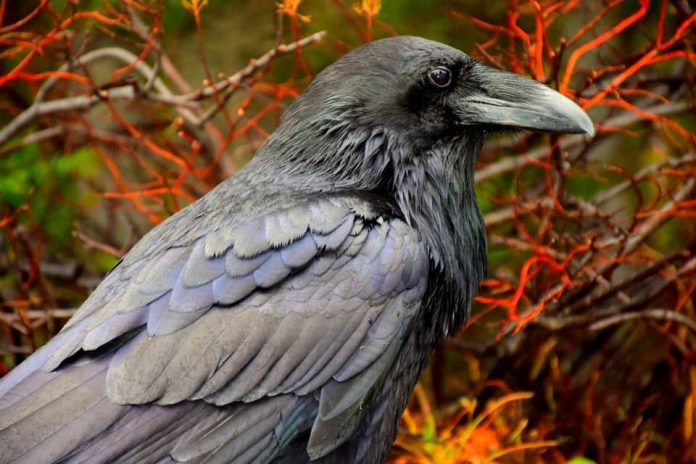
If you have ever observed a crow or raven close enough, you know there’s so much more to them than just those ominous rumors that go around. These delightful creatures are not only smart but also highly sociable (just not with humans), which might make you wonder: can they be kept as pets? Before getting into the specifics of the article, we’ll answer that in all brevity.
No, crows and ravens are illegal to pet in the United States (however, the legality varies in certain countries). They are illegal to pet in America under the Migratory Birds Act, first implemented in 1916, since allowing them to be owned will lead to a reckless capturing and selling of these creatures as novelty pets. Also, since these birds are partially migratory, you can’t capture them and lock them up in a cage both morally and lawfully.
Now that you know that they are illegal to pet let’s understand why you shouldn’t pet them in the first place.
Is it illegal to pet Crows and Ravens?
Yes, it is illegal to pet a crow or raven, and it’s not. How? Sadly, for corvid enthusiasts, the Migratory Bird Act, 1916 banned people of the United States from owning crows or ravens that are NATIVE TO THE UNITED STATES. However, you can legally own a crow or a raven that isn’t native to the states of America (although, we’d still suggest against it).
Why are they illegal to pet?
There are two reasons why you can’t pet a crow or raven in the US: first, they are wild creatures who, the law believes, should be left in the wild. There have been instances where people have tried stealing and reselling raven babies to be kept as exotic pets. Thus, officials who find a person wrongfully detaining a baby crow or raven take the creature into their custody to find them a new home in the wild.
Secondly, they are migratory birds that need to fly during certain seasons to survive and mate. Crows are partially migratory birds that migrate towards the south during the winters for myriad reasons.
However, the causes aren’t completely clear to the corvid researchers. Most commonly, it is believed that these corvids move from north to the southern areas to survive the cold during the chilly winters of the United States.

Which species of crows and ravens can you not pet?
Any American species of crow or raven is illegal to be pet by the residents of the country. The migratory corvids protected by the Migratory Bird Act are American crows and common ravens. Bummer! You can’t pet these two birds because they are partially migratory, and not being able to fly can deeply impact their mental and physical health.
It is a common notion that the ravens were imported from Europe whereas they can be found all over America, naturally, since ages. The ravens are also common to Asia, other than Europe, and these birds naturally settled in the US through traveling between continents post the ice ages. Some Of the Californian corvids have a completely different genetic legacy to their fellow mates in Europe and Asia.
Since these two birds are native to the American state, selling, stealing, and owning them is outright illegal and punishable by the law. They are so common and abundant in the US that you must be thinking that petting one will make no difference.
However, it is a necessary precaution that is very much likely to avoid the extinction or any threat to these native bird populations by restraining people from shamelessly seeking to sell them as novelty pets.
Why else shouldn’t you pet Crows and Ravens?
Although they are illegal to pet, let’s consider what would have happened even if they were legal to pet. First things first, on a moral stand, they are wild birds and should be left in the lap of nature.
Also, petting crows and ravens require specialized attention and care since it is arguably difficult and time consuming to look after them. Let’s understand why you shouldn’t be petting crows even if you were somehow (legally) able to.
1.) They are wild (and noisy)
We aren’t going to stretch this out, but crows and ravens are wild birds that should be left in nature, where they belong. They (and no other bird) like to be caged up and thrown in a corner for serving as an amusement.
Even if you were allowed to legally pet a crow, you shouldn’t because these wild creatures love freedom, and with their high intelligence, it’d be a shame to lock them up in a cage. Crows and ravens are curious animals that love exploring and discovering things, so keeping it in a confined space will bore it, degrading its personality- they do have individual personalities.
Crows and ravens can be obnoxiously noisy and loud, and the shrill caws aren’t any tunes you’d want to dance to. You can occasionally find them perching on the top of the lamppost, screaming in their shrill tone for 10 minutes straight- now imagine what it is going to be like inside your calm and serene home when you pet one.
The American Ravens and Crows can produce about 250 different calls, each one varying in severity, length, and shrillness. These caws serve their moods and actions such as begging, fighting, and alerting others in the group.
The high-pitched scream of crows and ravens can showcase a lot of emotions like anger, disappointment, pain, and sadness. Yes, they do feel emotions, just like we do, so their caws may be noisy and annoying for us, but that is how they communicate and express, and it isn’t their fault after all.
2.) Their bite can be bad
Ever noticed the long and potentially harmful beak that the crows and ravens possess? Yes, right. That beak may not be able to harm humans severely, but it can definitely make you bleed. In the worst-case scenario, their beak is powerful enough to break a bone in your finger- combine this with the fact that crows and ravens are aggressive. Bad for you!
Though their bite can break a small bone and cause pain, crows and ravens do not usually attack a person unless they are trying to protect their offspring or mate. Crows have a very sharp memory, and they can remember your face for as long as three years- so if you ever pestered it, be sure that it’ll be holding a grudge against you for quite some time. A crow can hit you with a flurry of wingbeats and may hammer your head with its sharp prodding beak, so beware!
How to avoid being bitten by a crow or raven?
If you ever got off on the wrong foot with a crow or raven, they may be holding grudges against you- they may also mob-bully you. What can you do in this case? The first thing you can do is wear a hat while you cross their territory.
You can also carry an umbrella so that the crows can’t attack you with their wings or hit their beak on your head. Most crows or ravens attack humans during their nesting period since they are very protective about their offspring, so avoid getting too close to their nests and the babies.
Lastly, desperate times call for desperate measures- the best way to ward off crows is to carry unsalted peanuts in your pocket while going out. Shelled peanuts are an even better option to distract crows, which will give you more time to escape while the crow is cracking open and feasting on its favorite food.

3.) They need to fly
These corvids are partially migratory birds, whereas some individuals, even within a roosting community, seem to migrate alone. The major reason as to why they are illegal to pet is that the American crows and ravens are partially migratory birds that usually move towards the south during winter. Crows that already have a residence in the southern parts don’t seem to be migrating as often as those in the Northern parts of the States.
Why do they migrate? Scientists aren’t sure. However, they believe it is an evolutionary path towards developing the ability to start with complete migration to distant parts of the world to survive.
They need much space
Crows are territorial animals that feel threatened when someone tries to intrude in their space. If you ever violate their privacy, be prepared to experience some loud and complaining vocalizations along with intense aggression.
In case you can ever manage to pet a crow or raven, you will have to build a huge aviary to let it have its own space- this can be both metaphorically and practically too costly. Hence, unless you want to throw your money down the drain, stop thinking of petting one.

4.) They are societal birds living in groups/ pairs
Crows are highly social animals that live in groups and pairs, so isolating a crow from its natural social environment is a huge ‘no-no.’ Both crows and ravens have a tight-knit family that consists of the partner, nestlings or yearlings, and other crow adults.
Crows and ravens roost in huge numbers, which can be in thousands, to help each other and survive against the predators like raccoons, owls, and hawks. A crow or raven never lives alone, and it is very important to find them a mate since they maintain one mate for the whole of their life.
There are some raven species where the non-mating adults, and most often the yearlings, live in a community. These communities are called roosting communities and are very important for the proper development of the crows, both physically and physiologically.
What is a group of crows called?
A group of crows or ravens is called a murder, and we aren’t completely sure why. There are myriad explanations; however, the most befitting one is possibly the fact that the mythologies have always considered crows to be ominous and a symbol of death.
The origin of the term ‘murder’ is sourced from these myths and old folk tales that paint these marvelous and surprisingly intelligent creatures in all the wrong colors.
However, we also believe that a ‘murder’ of crows reflects a time when people came up with all these crafty names for the wildlife. These poetic and sometimes ridiculous names have extended to not just crows but also peacocks (ostentation), owls (parliament), and so on.
What can you pet instead of a Crow or Raven?
It’s not like you can’t pet a crow or raven; it’s just that you can’t pet one that is native to the US. So, to legally acquire a crow/raven pet, start by picking a species that isn’t exclusive to America. The frequently bought and pet species of corvids are white neck ravens and pied crows. These two bird species never migrate to the US, both of them being native to Africa.
Some breeders will sell a hybrid of these two birds, and the offspring often share the traits of both the parents. These white-neck ravens and pied crows are usually sold as exotic pets since neither of them is protected by the law under the International Union’s endangered species status for the Conservation of Nature. Therefore, it is completely legal to acquire these birds as pets under ownership.
How much do they cost?
If you want to buy a raven or crow, we would suggest you find some reputed breeder who has a history of selling healthy crow/raven offsprings. Since these African corvids aren’t as widely sold and bred as the others (magpies and others), buying one can somewhat burn a hole in your wallet.
These corvids are sold for at least $2000 and $6000 at the most. There can also be additional shipping charges since white-neck ravens, and pied crows aren’t sold in every part of the United States.
How to befriend a Crow or Raven?
Well, if you can’t pet a crow, then what options are you left with? It’s simple- befriend it. It isn’t as ridiculous as it sounds. As we’ve mentioned numerous times in the article, crows and ravens are highly intelligent creatures that have also been seen to express emotions and recognize individual humans. This gives us a fair advantage to strike a meaningful friendship with a crow or raven. How? We’ll cover that in few basic steps:
Stock on its favourite food
So, this step may require a lot of patience and determination to try out different foods to analyze which one the crow or raven likes the most. Crows are surprisingly finicky, so if you think every crow likes the same food or plain meat, you’re wrong. A crow’s behavior can be a great indicator of which offer they like the most- however, make sure whatever you feed them is healthy and ultimately good for the crow.
A few favorite foods of crows and ravens:
- Unsalted peanuts, in the shell
- Hard-boiled eggs
- Wet or dry cat/dog foods
- Unsalted meat
- Table scraps
Keep a distance
These corvids are wild birds after all, so never try to get too cozy with them. If you try to get too close to them, there are possibilities- either the crow will be scared and fly away, or it will feel intimidated and, in turn, try to attack you.
Now, both of these scenarios are undesirable, so your goal is to befriend it, make yourself more acceptable, and not tame it. Observing these curious birds from a distance will keep the boundaries safe for them and us alike.
Keep it silent
Birds, including crows and ravens, like to enjoy their time in the quiet so, if there’s too much noise around you, they will never really come to you. They are cautious and solitary animals that may be standoffish even after months, so creating a quieter environment won’t just make them feel secure and safe while visiting you. It will also make it easy for you to befriend them.
Install a birdbath
Crows and ravens love to take a good bath, so if you want to lure one into your backyard or garden, install a birdbath. It will make the yard more enticing and help crows and other birds drink, cool off, and bathe in it. Adding the right size of birdbath will allow the crow to enjoy a deeper basin and have a sturdy ledge.
Establish a schedule
Establish a feeding schedule to let the relationship gel. This will help the crow or raven understand when you’ll be offering it food. When the crow starts appearing at the same place at the same time, it’s a good sign since the crow is now beginning to recognize you.
Keep in mind that although you are feeding it, you shouldn’t overdo it. Overdoing, it will only lead to confusion, and the crow or raven will now be completely dependent on you for food.


FAQs
How long do crows and ravens live in captivity?
In captivity, ravens and crows may live for more than 20-30 years- the oldest documented crow in captivity lived for 59 years. However, you shouldn’t keep crows or ravens in captivity on a moral basis since they are birds that need to travel long distances. When locked in a cage, these migratory birds often end up losing interest and will unambiguously be upset (they do have emotions).
If you’re nursing a crow back to health, keeping it captive for its own sake, you should free the bird as soon as you can since wildlife belongs to nature, not in human settlements.
How to catch a crow or raven to keep as a pet?
First and foremost, it is completely unethical to acquire a crow to keep as a pet and if you still wish to do so, check the legality in your country since it varies. If you want to catch a crow yourself, move to the solution and purchase a Larsen trap, but you can’t do it before licensing it online.
Once you have a license to use a Larsen trap to catch crows or ravens, deploy it in an open space with a live bird inside. Crows are intelligent animals that try to help each other, so if it finds another crow in distress, it’ll try to rescue it. This is your chance to trap it in and acquire it as a pet.
However, we completely discourage doing anything of this sort to these free and wild creatures since it lacks a sense of morality and humanity.
Do Ravens and Crows interbreed?
Yes, they do crossbreed, but there are higher chances that they just won’t. Ravens are bigger than crows, so crows see them as threats, and 97% of the time, crows try chasing ravens away from their territory.
Also, crow babies are an easy meal to ravens, which is why crows never let ravens loom around their nest too long. So, yes, there have been instances where crows and ravens have produced offspring, but they generally don’t because of the aggression, need for space, difference in interests, etc.
Do Crows and Ravens make the same sound?
No, they don’t make the same sound. Crows usually give a cawing sound while the Ravens produce low croaking sounds. Ravens can even imitate a huge variety of sounds, whereas the crows can’t.
The crows may produce rattling sounds and shrill squeaks, but a raven, if raised in captivity or one that has learned to recognize and spend time with humans, can imitate various sounds such as flushing of the toilet, starting of an engine. Some ravens are shown to talk and mimic human voices better than parrots; however, crows lack this ability.
Do Crows and Ravens get along?
Though crows and ravens share similar resemblance, it’d be wrong to think that they get along. Crows are aggressive, and so are ravens. However, the major reason why they can’t get along is that ravens are predators to crows. Ravens can kill crows in a mob fight while also being a constant threat to their preserved food sources.
Crows do not like to share the same space with ravens since they try to protect their offspring from becoming an easy and nutritious meal. This is one of the reasons why crows are seen to be attacking and chasing off ravens in about 97% of cases, even though ravens are much larger.
Are Crows and Ravens intelligent?
They are intelligent; in fact, they are one of the smartest species of birds. Crows have a large brain to body ratios, and their intelligence level is quite close to chimpanzees and humans.
Their intelligence and fearless attitude makes them deadly predators. Ravens can imitate a different variety of sounds, and they can even understand human speeches. Just like humans, they can make tools and use them efficiently.
Yes, they are different, but you may not be able to differentiate among themselves. Though they look similar to you, there is a difference in their flight pattern, behavior, and their size. Ravens are larger in size with wedge-shaped tails and large bill, whereas the Crows have a fan-shaped tail and small bill. There is a difference between Raven and Crow’s call, and the Ravens are slightly more intelligent than the Crows.
Interesting Facts About Ravens and Crows
They are playful: These acrobatic fliers are found rolling, somersaulting in the air, and sometimes playing with a stick by dropping them in the air and then catching it before it touches the ground.
Both Crows and Ravens are intelligent: A Raven’s intelligence makes it a deadly predator. Though Ravens are solitary, they gather in flocks to hunt large animals. They call the wolves to a carcass to tear the animal’s body and make the scrape more accessible. While hiding their food, if they come to know that another Raven is keeping an eye on them, they pretend to hide but hide the food somewhere else. They raid on the eggs of other birds while one of them is distracting an incubating adult.
The brain to body ratio of crows is equivalent to the apes. This makes them one of the intelligent birds who have problem-solving skills and awesome communication skills.
They can also be white in color: The rare white-colored Ravens are found in Canada, near Qualicum Beach. A genetic disorder called leucism is the reason why the Crows and Ravens are white-colored.
Ravens can imitate sounds: Ravens can imitate sounds of their environment, and when raised in captivity and trained, they can imitate human speeches. In the wild, Ravens communicate with each other by making varied sounds, and they even express their emotions with these random sounds. Ravens can even produce other birds’ sounds, including clapping, toilet flushing, garbage trucks, and wing whistles.
Crows communicate among themselves by making different types of sounds and even imitate the cry of other birds.
They are highly adaptable: Both Crows and Ravens can live in various habitats, ranging from snow, desert mountains to forests and these scavengers can easily survive and feed on fish, meat, seeds, fruit, carrion, and garbage.
Ravens don’t tolerate a cheat: Ravens work together and get equal shares of food, but if a Raven takes more food than its share, then the other Ravens lose trust and never cooperate cheat in the future.
Crows and Ravens remember faces: Just like humans and primates, Ravens and Crows can also remember faces and other characteristics, and it is because of their episodic memory. If mistreated, Crows hold grudges, and they pass on this grudge among the others too.
Ravens are empathic: Ravens are surprisingly empathic, who share their feelings with each other. They console the victim Reven who lost a fight, by beak to body touch, preening, and sitting close to them.
Ravens also use “hand” gestures: Just like humans and primates use hand gestures, Ravens use their beaks and wings to point at an object or to get their attention and even interact with each other by clasping their bills together.
The groups of Crows and Ravens are referred to by several spooky names: Ravens are traditionally considered as negative beings, and hence they got spooky names like unkindness, conspiracy, or constable. A group of crows is called murder.
Crows hold funerals for their dead fellows: Whenever a crow dies, the other crows gather around and make a lot of noise. They do this to learn about the cause of death and threats.
Sources:
- Brian Mertins, Crow Territorial Behavior, Nature Mentoring.
- How to Befriend Crows?, World birds.
- 8 tips to prevent crow attacks, Dailyhive.






